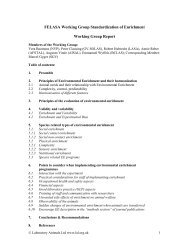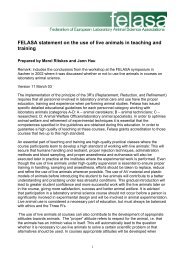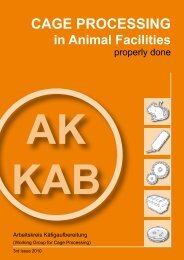IVC systemsIndividually ventilated cages. This means cage systems for hygienic/allergic protection of animals and humans/surround<strong>in</strong>gs.To achieve this protection, cage bases are closed and locked with tops. Individual ventilationsystems allow for a proper air supply of the animals.LAFLam<strong>in</strong>ar-Air-FlowLoad<strong>in</strong>g trolleyA load<strong>in</strong>g trolley is a mobile rack for load<strong>in</strong>g and mov<strong>in</strong>g different types of items <strong>in</strong>to a washer or steriliser.Different types of items and mach<strong>in</strong>es require different types of load<strong>in</strong>g trolleys.MAC valueThe MAC value <strong>in</strong>dicates the maximum allowable concentration of hazardous substances <strong>in</strong> form of gas,steam, or aerosols <strong>in</strong> workplace air that, accord<strong>in</strong>g to current knowledge, pose no risk to the health of employeesand are no major disturbance either, even with employees be<strong>in</strong>g exposed to them over a longer period,which means a work time of eight hours a day.MediaThis term sums up all utilities (usually steam and water) and process chemicals.Occupational risk assessmentA workplace should be as low risk as possible. Therefore, every employer is to conduct a risk assessment ofthe possible threats posed <strong>in</strong> every job he/she offers. For pr<strong>in</strong>ciples and methods of occupational risk assessment,please consult the labour protection act, ord<strong>in</strong>ance on <strong>in</strong>dustrial safety and health, and ord<strong>in</strong>ance onhazardous substances as def<strong>in</strong>ed by your respective country. The aspects described below should be considered<strong>in</strong> particular:• risks that occur with general job work, for example <strong>in</strong> the course of certa<strong>in</strong> work procedures (assessmentof the entire work rout<strong>in</strong>e – “synopsis”: selection/comb<strong>in</strong>ation/<strong>in</strong>teraction of different mach<strong>in</strong>es, hazardoussubstances, physical position<strong>in</strong>g, employee skills, etc.),• risks that occur when work<strong>in</strong>g with hazardous substances, like detergents and dis<strong>in</strong>fectants (protectionlevel concept),• risks that occur when handl<strong>in</strong>g work equipment, like mach<strong>in</strong>es, <strong>in</strong> <strong>in</strong>teraction with, for example, hazardoussubstances,• test <strong>in</strong>tervals for mach<strong>in</strong>e parts, mach<strong>in</strong>es, and the overall system.Details on occupational risk assessment can also be found <strong>in</strong> the guidel<strong>in</strong>es of government safety organisationsor of the regional authorities charged with the pr<strong>in</strong>ciples and methods of occupational safety.PAA lockLock for transferr<strong>in</strong>g heat-sensitive products <strong>in</strong> and out of a barrier area by means of steam sterilisation. Thedis<strong>in</strong>fectant thereby used is peracetic acid.pH ValueDiluted solutions are classified <strong>in</strong>to highly acid, mildly acid, neutral, mildly alkal<strong>in</strong>e, highly alkal<strong>in</strong>e with the pHvalue as the measur<strong>in</strong>g unit. The numerical scale ranges from 0 - 14 whereas values < 7 <strong>in</strong>dicate the acid andvalues > 7 the alkal<strong>in</strong>e scale. Diluted solutions with a pH value of 7 are classified as neutral.Process capability of bedd<strong>in</strong>gEvery process is adapted to certa<strong>in</strong> products, so are semi or fully automated bedd<strong>in</strong>g dispens<strong>in</strong>g systems.Some very fibrous types of bedd<strong>in</strong>g, when put <strong>in</strong>to conta<strong>in</strong>ers, are prone to bridg<strong>in</strong>g, which makes them hardto dispense evenly. The result would be cages with vary<strong>in</strong>g fill<strong>in</strong>g quantities.Process chemicalsCollective term for detergents, neutralisers, and r<strong>in</strong>se aids, added to the water <strong>in</strong> automated process<strong>in</strong>g.70Cage Process<strong>in</strong>g <strong>in</strong> <strong>Animal</strong> <strong>Facilities</strong> · 4th issue · 2013
Process<strong>in</strong>gProcess<strong>in</strong>g means wash<strong>in</strong>g, dis<strong>in</strong>fect<strong>in</strong>g, and sterilis<strong>in</strong>g all items that are transferred from the process<strong>in</strong>g centre(or wash-up area) to the animal hous<strong>in</strong>g area, <strong>in</strong>clud<strong>in</strong>g all associated empty<strong>in</strong>g, fill<strong>in</strong>g, and transport<strong>in</strong>g/carry<strong>in</strong>g activities.Process<strong>in</strong>g centrePlease refer to wash-up area.Recirculation systemIn the recirculation system of a washer the spray water mixed with detergents is recirculated and thus repeatedlysprayed on the items to be processed.Scoop<strong>in</strong>g cavitiesHollows and areas on items that are prone to accumulat<strong>in</strong>g residual liquid and dirt.SOPStandard Operation ProceduresSPF areaArea for hous<strong>in</strong>g and breed<strong>in</strong>g specific pathogen free animals.Spray waterSpray water is the water <strong>in</strong> automated washers, potentially mixed with process chemicals, that is pressure-sprayedvia jets on items for process<strong>in</strong>g.Steam sterilisationA validatable procedure for remov<strong>in</strong>g viable microorganisms.Thermo labile and thermo stable itemsRefer to chapter 4.5.1.1TitrationTitrimetric method for determ<strong>in</strong><strong>in</strong>g the amount of substances <strong>in</strong> liquids (method for def<strong>in</strong><strong>in</strong>g the substance concentration).Drops of a reagent of known concentration (standard solution) are added with a burette to a givensubstance till the concentration is even and the <strong>in</strong>dicator <strong>in</strong> the standard solution shows a colour change.Tolerable residual moistureA tolerable residual moisture means s<strong>in</strong>gle water drops (no puddles of water) adher<strong>in</strong>g to items <strong>in</strong> adversespots after be<strong>in</strong>g removed from the washer. Subsequent steps of item process<strong>in</strong>g are not affected.Wash<strong>in</strong>gRemov<strong>in</strong>g soil<strong>in</strong>g off objects to a degree necessary for further process<strong>in</strong>g or designated use.Wash-up areaAll mach<strong>in</strong>es necessary for wash<strong>in</strong>g, dis<strong>in</strong>fection, and steam sterilisation of items are located <strong>in</strong> close vic<strong>in</strong>ity<strong>in</strong> the wash-up area (also process<strong>in</strong>g centre).Work exposure limit (WEL)The work exposure limit (WEL) describes the limit of the time-assessed average concentration of a substance<strong>in</strong> workplace air for a given reference period. It <strong>in</strong>dicates the safe concentration of a substance where noacutely or chronically harmful effects on health <strong>in</strong> general can be expected. The limit is generally based on apresumed eight hour exposure to a substance five days a week of an entire work<strong>in</strong>g life. The work exposurelimit is <strong>in</strong>dicated <strong>in</strong> mg/m³ and ml/m³ (ppm). (Please consult the ord<strong>in</strong>ance on hazardous substances as def<strong>in</strong>edby your respective country/EU standards.)Cage Process<strong>in</strong>g <strong>in</strong> <strong>Animal</strong> <strong>Facilities</strong> · 4th issue · 2013 71






